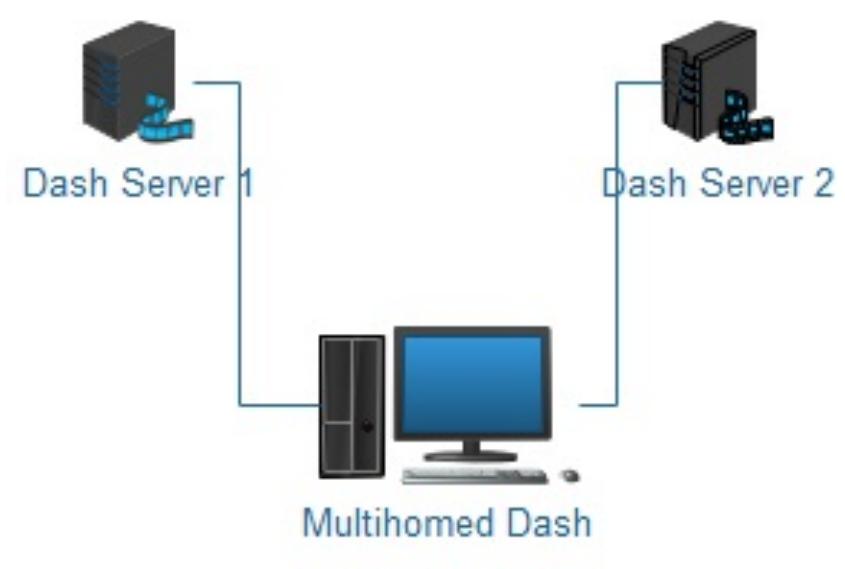Parallel Streaming for a Multi-homed Dash client
2020 International Wireless Communications and Mobile Computing (IWCMC)
https://doi.org/10.1109/IWCMC48107.2020.9148354Abstract
Nowadays, multimedia streaming traffic reaches 71 % from the mobile data traffic over the world and most of the multimedia services use Dynamic adaptive streaming over HTTP (DASH) to adjust video delivery to the dynamic network environment and achieve higher user Quality of Experience (QoE) levels. Moreover, 90 % of the video traffic is consumed by smart devices equipped with multiple network interfaces (Wifi, 3G, and 4G) known as multi-homed devices. In this paper, we propose a new DASH-parallel streaming solution, which exploits the diversity of access network connections to improve video quality over DASH protocol. Experimental Results show that our proposed approach improves the perceived QoE in different network conditions, without requiring further energy expenditure. Index Terms-MPEG-DASH,multi-homing and parallel streaming.
FAQs
AI
What are the main benefits of parallel streaming in multi-homed DASH clients?
Parallel streaming enhances video quality by utilizing multiple connections, achieving 95% average bitrate improvement in 80% of scenarios tested. It also improves robustness by enabling connection switching during congestion or failure.
How does PS-DASH handle packet ordering to enhance video quality?
PS-DASH prioritizes seamless video transmission by downloading segments from both ends simultaneously, avoiding head-of-line blocking. This intra-segment approach allows for maintaining video integrity despite varying network conditions.
What methodology was used to evaluate the performance of PS-DASH?
The proposed solution was tested across 192 scenarios simulating diverse network throughput with smooth and rough variations. Key metrics included average video bitrate and buffering time, with results indicating consistent quality enhancement.
When is parallel streaming not utilized in the PS-DASH framework?
Parallel streaming is minimized when maximum video quality can be achieved through a single connection, reducing energy consumption. Observations showed usage dropped from 70% to 18% in optimal conditions.
How does PS-DASH address energy consumption during video streaming?
The algorithm actively monitors network conditions and only engages parallel streaming when it offers improved quality, thereby conserving energy. Future upgrades aim to integrate buffer status into energy management strategies.
References (19)
- Samsung galaxy s5 download booster, 2019. "https://galaxys5guide.com/ samsung-galaxy-s5-features-explained/galaxy-s5-download- booster/".
- V. K. Adhikari, Yang Guo, Fang Hao, M. Varvello, V. Hilt, M. Steiner, and Z. Zhang. Unreeling netflix: Understanding and improving multi- cdn movie delivery. In 2012 Proceedings IEEE INFOCOM, pages 1620- 1628, March 2012.
- T. Casey and G. Muntean. Mpeg-dash-based framework for improving end-user video experience in heterogeneous multi-network wireless environments. In 2016 IEEE International Symposium on Broadband Multimedia Systems and Broadcasting (BMSB), pages 1-6, June 2016.
- Y. Chowrikoppalu and P. Gowda. Multipath Adaptive Video Streaming over Multipath TCP. PhD thesis, University of Saarland, 2013.
- Cisco. Cisco visual networking index forecast and methodology, 2019. Available at https://www.cisco.com/c/en/us/solutions/collateral/service- provider/visual-networking-index-vni/vni-forecast-qa.html.
- Xavier Corbillon, Ramon Aparicio Pardo, Nicolas Kuhn, Géraldine Texier, and Gwendal Simon. Cross-layer scheduler for video streaming over mptcp. pages 1-12, 05 2016.
- Bo Han, Feng Qian, Lusheng Ji, and Vijay Gopalakrishnan. Mp-dash: Adaptive video streaming over preference-aware multipath. pages 129- 143, 11 2016.
- A. Hodroj, M. Ibrahim, Y. Hadjadj-Aoul, and B. Sericola. Enhancing dynamic adaptive streaming over http for multi-homed users using a multi-armed bandit algorithm. In 2019 15th International Wireless Communications Mobile Computing Conference (IWCMC), pages 692- 697, June 2019.
- P. Houzé, E. Mory, G. Texier, and G. Simon. Applicative-layer multipath for low-latency adaptive live streaming. In 2016 IEEE International Conference on Communications (ICC), pages 1-7, May 2016.
- Dynamic adaptive streaming over http (dash) -part 6: Dash with server push and websockets. Standard, International Organization for Standardization, March 2017.
- C. Mueller, S. Lederer, C. Timmerer, and H. Hellwagner. Dynamic adaptive streaming over http/2.0. In 2013 IEEE International Conference on Multimedia and Expo (ICME), pages 1-6, July 2013.
- H. Nam, D. Calin, and H. Schulzrinne. Towards dynamic mptcp path control using sdn. In 2016 IEEE NetSoft Conference and Workshops (NetSoft), pages 286-294, June 2016.
- T. Ojanperä and J. Vehkaperä. Network-assisted multipath dash using the distributed decision engine. In 2016 International Conference on Computing, Networking and Communications (ICNC), pages 1-6, Feb 2016.
- I. Sodagar. The mpeg-dash standard for multimedia streaming over the internet. IEEE MultiMedia, 18(4):62-67, April 2011.
- J. Vlaović, S. Rimac-Drlje, F. Vranješ, and R. P. Kovač. Evaluation of adaptive bitrate selection algorithms for mpeg dash. In 2019 International Symposium ELMAR, pages 73-76, Sep. 2019.
- Wondershaper, 2011. Available at https://github.com/magnific0/wondershaper.
- M. Xing, S. Xiang, and L. Cai. A real-time adaptive algorithm for video streaming over multiple wireless access networks. IEEE Journal on Selected Areas in Communications, 32(4):795-805, April 2014.
- Min Xing, Siyuan Xiang, and Lin Cai. Rate adaptation strategy for video streaming over multiple wireless access networks. pages 5745-5750, 12 2012.
- Y. Zhou, Y. Duan, J. Sun, and Z. Guo. Towards simple and smooth rate adaption for vbr video in dash. In 2014 IEEE Visual Communications and Image Processing Conference, pages 9-12, Dec 2014.
 Ali HODROJ
Ali HODROJ








